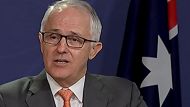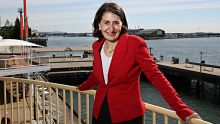International passengers would be whisked through immigration and customs without stopping or even encountering humans, while passport scanners and paper cards would be a thing of the past, under a radical overhaul of Australia's airports due to start this year.
The Department of Immigration and Border Protection has sought technology that would abolish incoming passenger cards, remove the need for most passengers to show their passports and replace manned desks with electronic stations and automatic triage.
More NSW News Videos
Turnbull: Need for western Sydney airport 'screamingly obvious'
Prime Minister Malcolm Turnbull has signed off on the plan to build a second Sydney airport in Badgerys Creek. Vision courtesy ABC News 24.
The plan goes much further than the SmartGates currently installed at some airports that require passports to be scanned electronically. Those gates, introduced less than 10 years ago, will be retired as part of the new "contactless" system.
Instead, passengers will be processed by biometric recognition of the face, iris and/or fingerprints, matched to existing data. By 2020 the government wants a system in place to process 90 per cent of travellers automatically, with no human involvement.

"I think it could be a world first," said John Coyne, head of border security at the Australian Strategic Policy Institute. He said it was the long-term vision of the most senior immigration bureaucrats to "streamline" the arrivals process so international passengers could "literally just walk out like at a domestic airport".
The Seamless Traveller project has been in train since 2015, with almost $100 million budgeted over five years, but the DIBP has only now embarked on the most ambitious aspect of the project, which it says will "transform the border experience".
Though the government knows what it is looking for, it doesn't yet know what it's going to get. "The department is asking tenderers to provide innovative solutions to allow arriving travellers to self-process," an immigration spokeswoman said.
"The department has not therefore defined the specific solution or how it will differ from existing arrivals or departures SmartGates."

Dr Coyne said it was possible early iterations of the technology would filter incoming passengers through a corridor, rather than individual gates, where their biometrics were captured and checked without the passenger ever stopping.
"Biometrics are now going in leaps and bounds," he said. "Our ability to harness the power of big data is increasing exponentially."
The department wants to pilot the technology in July at Canberra Airport, which handles limited flights to Singapore and Wellington. It would be introduced at a major airport such as Sydney or Melbourne in November, with the rollout completed by March 2019.
The innovation was possible because of the massive amount of passenger data – including ticket information, travel history and criminal records – sourced globally and analysed in the back room, Dr Coyne said.
He said Australia was "miles ahead of the majority of countries" in modernising airport technology, particularly compared with the US or London's Heathrow, which he labelled "an informed version of the Middle Ages".
In previous statements, Immigration Minister Peter Dutton said advancements in border technology would enable Border Force officials to concentrate resources on passengers of interest.
Dr Coyne said it was all about "selective permeability", or using intelligence to determine in advance which types of passengers posed a risk – and getting everyone else through more efficiently.
"All of this is about risk," he said. "I think in Australia we're doing exceptionally well."















